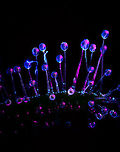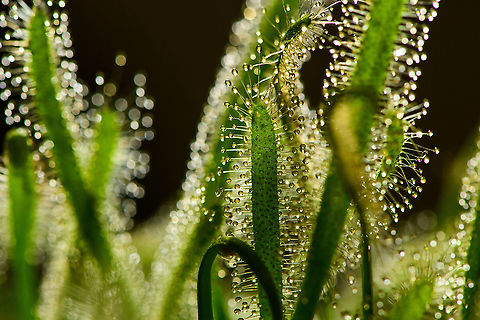 Promoted
Promoted
Cape Sundew - UV, Heesch, Netherlands
This is what I would call a uniquely stupid idea.
I had just acquired a lighting system that has various LED arms. One particular arm emits UV light only. I had already tested it succesfully on lichen, I'll post those later. I also did a nightly stroll through the garden, pointing the arm everywhere to see which flower lights up. Pre-selecting targets, in a way.
What else could I try, my fuzzy mind wondered? When the dots connected, I cringed. How about the sundews you just spent 3 days stacking? The answer was in plain sight. How slow the idea came into existence, it does seem unique enough, I'm not finding any serious comparisons of trying this on sundews.
It's easy to see why if you consider the process involved. Consumer grade UV lights are extremely weak, for safety reasons. You have to almost touch the subject with the light in a fully dark room to see the effect at all.
This is a problem for extreme macro, which needs the exact opposite: extreme amounts of light. As more UV light is no option for now, the only solution is shutter speed. Where normally 1/60s is already too slow for extreme macro due to micro vibrations, this stack consists of photos with a 3s shutter speed.
That's not the only pain. You can't see what you're doing so you have to prepare the entire stack in normal light. Do the composition, focus start and end points. Then, position UV lighting without touching or moving anything and pray you got it right, as you can't preview any result. Finally, shut down all lights in the house, press start, and sit motionless in complete darkness on the couch, wondering how I ended up here.
I couldn't believe what I saw after the stacking software did its job. It was getting late, so I went to bed, still hyped. With the full weekend still ahead of me, I was totally going to produce a whole series of this effect. I spent 2 nights in a row, hours on end, without producing a single usable shot.
I got lucky. Correct angle and distance. That said, I've since produced a few more, but I share in order, so those will come later. As I cannot make up my mind which orientation is best, by exception I'm sharing both orientations.
Fun detail: note the little dust thread. Normally a problem, but under UV it lights up like lighting and reflects in the glandular hairs.


''Drosera capensis'', commonly known as the Cape sundew, is a small rosette-forming carnivorous species of perennial sundew native to the Cape in South Africa. Because of its size, easy to grow nature, and the copious amounts of seed it produces, it has become one of the most common sundews in cultivation.

comments (6)
Much more time goes into preparing the stack: composition, focus, start and end point, finding appropriate exposure values, etc. I'd say 80% of stacking is preparation and testing, 10% running the stack, 10% for the software process. Posted 5 years ago